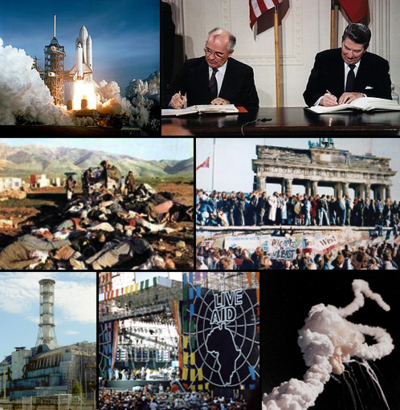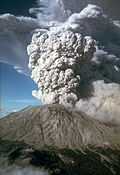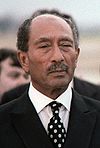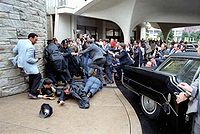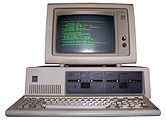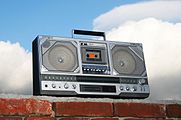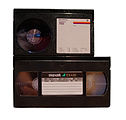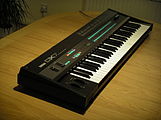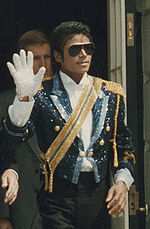- 1980s
-
"Eighties" redirects here. For the song by Killing Joke, see Eighties (song).From left, clockwise: The first Space Shuttle, Columbia, lifted off in 1981; American President Ronald Reagan and Soviet leader Mikhail Gorbachev eased tensions between the two superpowers, leading to the end of the Cold War; The Fall of the Berlin Wall in 1989 is considered to be the most momentous event of the 1980s; In 1986, six astronauts and one teacher died in the Challenger disaster; In 1985, the Live Aid concert was held in order to fund relief efforts for the famine in Ethiopia; Ukraine and much of the world is filled with radioactive debris from the 1986 Chernobyl disaster; The Iran–Iraq War leads to over one million dead and $1 trillion spent.

Millennium: 2nd millennium Centuries: 19th century – 20th century – 21st century Decades: 1950s 1960s 1970s – 1980s – 1990s 2000s 2010s Years: 1980 1981 1982 1983 1984 1985 1986 1987 1988 1989 Categories: Births – Deaths – Architecture
Establishments – DisestablishmentsThe 1980s, spoken as "the Nineteen Eighties" or abbreviated as "The Eighties" or "the 80s", was the decade that began on January 1, 1980, and ended on December 31, 1989, and was the start of the eighth decade and ended on the ninth decade of the 20th century.
The time period saw great social, economic, and general change as wealth and production migrated to newly industrializing economies. As economic liberalization increased in the developed world, multiple multinational corporations associated with the manufacturing industry relocated into Thailand, Malaysia, Mexico, South Korea, Taiwan, China, and new market economies in Eastern Europe following the collapse of communism in eastern Europe. Japan and West Germany are the most notable developed countries that continued to enjoy rapid economic growth during the decade while other developed nations, particularly the United States and United Kingdom, re-adopted laissez-faire economic policies.
Developing countries across the world faced economic and social difficulties as they suffered from multiple debt crises in the 1980s, requiring many of these countries to apply for financial assistance from the International Monetary Fund (IMF) and the World Bank. Ethiopia witnessed widespread famine in the mid-1980s, resulting in the country having to depend on foreign aid to provide food to its population and worldwide efforts to address and raise money to help Ethiopians, such as the famous Live Aid concert in 1985.
Major civil discontent and violence occurred in the Middle East, including the Iran-Iraq War, the ongoing Soviet-Afghan War, the 1982 Lebanon War, the Bombing of Libya in 1986, and the First Intifada in the Gaza Strip and the West Bank.
In the eastern world, hostility to authoritarianism and the failing command economies of communist states resulted in a wave of reformist policies by communist regimes such as the policies of perestroika and glasnost in the Soviet Union, along with the overthrows and attempted overthrows of a number of communist regimes, such as in Poland, Hungary, the Tiananmen Square protests of 1989 in China, the Czechoslovak "Velvet Revolution", and the overthrow of the Nicolae Ceauşescu regime in Romania and other communist Warsaw Pact states in Central and Eastern Europe. It came to be called the late 1980s' "purple passage of the autumn of nations". By 1989, with the disintegration of the Warsaw Pact, the Soviet Union announced the abandonment of political hostility toward the western world and, thus, the Cold War ended. These changes continued to be felt in the 1990s and into the 21st century.
Contents
Politics and wars
Terrorist attacks
Main article: List of terrorist incidents#1970s–2000sThe most notable terrorist attacks of the decade include:
- Air India Flight 182 was destroyed on June 23, 1985 by Sikh-Canadian militants. It was the biggest mass murder involving Canadians in Canada's history.
- The Rome and Vienna airport attacks take place on December 27, 1985 against the Israeli El Al airline. The attack was done by militants loyal to Abu Nidal, backed by the government of Libya.
- The 1983 Beirut barracks bombing - during the Lebanese Civil War two truck bombs struck separate buildings housing United States and French military forces killing 299 American and French servicemen. The organization Islamic Jihad claimed responsibility for the bombing.
- The Lockerbie Disaster on 21 December 1988, when a Boeing 747-121 was blown up over the village of Lockerbie, Scotland while enroute from London's Heathrow Airport to New York's JFK. The bombing killed all 243 passengers, 17 crew members and 11 people on the ground, totaling 270 fatalities who were citizens of 21 nationalities. The bombing was and remains the worst terrorist attack on UK soil.
- Salvadoran Civil War 1980-1992, part of the cold war conflicts, reached its peak in the 1980s, 70,000 salvadorans died.
Wars
Main article: List of wars 1945–1989#1980–1989The most prominent armed conflicts of the decade include:
International wars
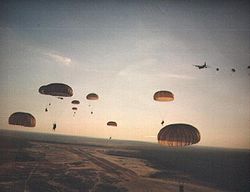 Invasion of Grenada, 1983.
Invasion of Grenada, 1983.

The most notable wars of the decade include:
- The Cold War (1945–1991)
- Soviet war in Afghanistan (1979–1989) - a war fought between the Soviet Union and the Islamist Mujahideen Resistance in Afghanistan. The mujahideen found other support from a variety of sources including the United States, Saudi Arabia, Pakistan, and other Muslim nations through the context of the Cold War and the regional India-Pakistan conflict.
- Invasion of Grenada (1983) - a 1983 U.S.-led invasion of Grenada, triggered by a military coup which ousted a brief revolutionary government. The successful invasion led to a change of government but was controversial due to charges of American imperialism, Cold War politics, the involvement of Cuba, the unstable state of the Grenadian government, and Grenada's status as a Commonwealth realm.
- Arab–Israeli conflict (Early 20th century-present)
- 1982 Lebanon War - The Government of Israel ordered the invasion as a response to the assassination attempt against Israel's ambassador to the United Kingdom, Shlomo Argov by the Abu Nidal Organization and due to the constant terror attacks on northern Israel made by the terrorist organizations which resided in Lebanon. After attacking the PLO, as well as Syrian, leftist and Muslim Lebanese forces, Israel occupied southern Lebanon and eventually surrounded the PLO in west Beirut and subjected to heavy bombardment, they negotiated passage from Lebanon.
- The Iran-Iraq war took place from 1980 to 1988. Iraq was accused of using illegal chemical weapons to kill Iranian forces and against its own dissident Kurdish populations. Both sides suffered enormous casualties, but the poorly equipped Iranian armies suffered worse for it, being forced to use soldiers as young as 15 in human-wave attacks. Iran finally agreed to an armistice in 1988.
- Argentina invaded the Falkland Islands (or Islas Malvinas, as they are known in Spanish-speaking countries), sparking the Falklands War. It occurred from 2 April 1982–14 July 1982 between the United Kingdom and Argentina as British forces fought to recover the islands. Britain emerged victorious and its stance in international affairs and its long decaying reputation as a colonial power received an unexpected boost. The military junta of Argentina, on the other hand, was left humiliated by the defeat; and its leader Leopoldo Galtieri was deposed three days after the end of the war. A military investigation known as the Rattenbach report even recommended his execution.
- The United States launched an aerial bombardment of Libya in 1986 in retaliation for Libyan support of terrorism and attacks on US personnel in Germany and Turkey.
- The South African Border War between South Africa and the alliance of Angola, Namibia, and Zambia ended in 1989, ending over thirty years of conflict.
- The United States engaged in significant direct and indirect conflict in the decade via alliances with various groups in a number of Central and South American countries claiming that the U.S. was acting to oppose the spread of communism and end illicit drug trade. The U.S. government supported the government of Colombia's attempts to destroy its large illicit cocaine-trafficking industry and provided support for right-wing military government in the Salvadoran civil war which became controversial after the El Mozote massacre on December 11, 1981 in which U.S.-trained Salvadoran paramilitaries killed 1000 Salvadoran civilians. The United States, along with members of the Organisation of Eastern Caribbean States, invaded Grenada in 1983. The Iran-Contra affair erupted which involved U.S. interventionism in Nicaragua, resulting in members of the U.S. government being indicted in 1986. U.S. military action began against Panama in December 1989 to overthrow its president, Manuel Noriega.
- Battle of Cuito Cuanavale took place as part of the Angolan civil war and South African Border War from 1987 to 1988. The battle involved the largest fighting in Africa since World War II between military forces from Angola, Cuba (expeditionary forces), and Namibia versus military forces from South Africa and the dissident Angolan UNITA organization.
- The Nagorno-Karabakh War between Azerbaijan and the Armenia started in 1988 and lasted six years.
Civil wars and guerrilla wars
The most notable Internal conflicts of the decade include:
- The Tiananmen Square protests of 1989 occurred in the People's Republic of China in 1989, in which pro-democracy protestors demanded political reform. The protests were crushed by the People's Liberation Army.
- The First Intifada (First Uprising) in the Gaza Strip and West Bank began in 1987 when Palestinian Arabs mounted large-scale protests against the Israeli military presence in the Gaza Strip and West Bank, which the Palestinians claim as their own. The Intifada soon became violent as the Israeli army and Palestinian militants fought for control over the disputed territories. The First Intifada would continue until peace negotiations began between the Palestinian Liberation Organization (PLO) and the Israeli government in 1993.
- Lebanese Civil War (1975–1990) - Throughout the decade, Lebanon was engulfed in civil war between Islamic and Christian factions.
- The Kanak Socialist National Liberation Front began a violent campaign for independence in New Caledonia.
- Greenpeace's attempts to monitor French nuclear testing on Mururoa were halted by the sinking of the Rainbow Warrior.
- The Second Sudanese Civil War erupts in 1983 between the Muslim government of Sudan in the north and non-Muslim rebel secessionists in Southern Sudan. The conflict continues through the present day Darfur genocide.
- Peru faced the beginning of internal conflict by the communist Túpac Amaru Revolutionary Movement in 1980 that would continue until the end of the 1990s.
- Haitian dictator Jean-Claude Duvalier was overthrown by a popular uprising on February 6, 1986.
Coups
Main article: List of coups d'état and coup attempts#1980 - 1989The most prominent coups d'état of the decade include:
- Nigeria suffered multiple military coups in 1983 and 1985.
- Sitiveni Rabuka staged two military coups in Fiji in 1987, and declared the country a republic the same year.
Nuclear threats
 The Israeli Air Force F-16A Netz '243' which was flown by Colonel Ilan Ramon during Operation Opera.
The Israeli Air Force F-16A Netz '243' which was flown by Colonel Ilan Ramon during Operation Opera.
- Operation Opera - a 1981 surprise Israeli air strike that destroyed the Iraqi nuclear reactor being constructed in Osirak. Israeli military intelligence assumed this was for the purpose of plutonium production to further an Iraqi nuclear weapons program. Israeli intelligence also believed that the summer of 1981 would be the last chance to destroy the reactor before it would be loaded with nuclear fuel.
- President Reagan's decision to station intermediate-range nuclear missiles in Western Europe provoked mass protests involving more than one million people.
Decolonization and independence
- Canada gained official independence from the United Kingdom with a new Constitution on 17 April 1982, authorized by the signature by Elizabeth II. This act severed all political dependencies of the United Kingdom in Canada (although the Queen remained the titular head of state).
- In 1986, Australia and the United Kingdom fully separated Australia's governments from the influence of the British Parliament, resulting in a consolidation of Australia's independence that had been granted a century before.
- In 1986, New Zealand and the United Kingdom fully separated New Zealand's governments from the influence of the British Parliament, resulting in New Zealand's full independence with the Constitution Act 1986 which also reorganised the government of New Zealand.
- Independence was granted to Vanuatu from the British/French condonimum (1980), Kiribati from joint US-British government (1981) and Palau from the United States (1986).
- Zimbabwe becomes independent from official colonial rule of the United Kingdom in 1980.
- Independence was awarded to Antigua and Barbuda, Belize (both 1981), and Saint Kitts and Nevis (1983) of the Caribbean; and Brunei of Southeast Asia in 1984
Prominent political events
Americas
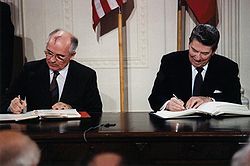 U.S. President Reagan and Soviet General Secretary Gorbachev signing the INF Treaty, 1987.
U.S. President Reagan and Soviet General Secretary Gorbachev signing the INF Treaty, 1987.
- Ronald Reagan was elected U.S. President in 1980. In international affairs, Reagan pursued a hardline policy towards preventing the spread of communism, initiating a considerable buildup of U.S. military power to challenge the Soviet Union. He further directly challenges the Iron Curtain by demanding that the Soviet Union dismantle the Berlin Wall.
- The Reagan Administration accelerated the War on Drugs, publicized through anti-drug campaigns including the Just Say No campaign of First Lady Nancy Reagan. Drugs became a serious problem in the '80s. Cocaine was popular among celebrities and the young, sophisticated "yuppies", while crack, a cheaper and more potent offshoot of the drug, turned the inner cities into war zones.
- Political unrest in the province of Quebec, which, due to the many differences between the dominant francophone population and the anglophone minority, and also to francophone rights in the predominantly English-speaking Canada, came to a head in 1980 when the provincial government called a public referendum on partial separation from the rest of Canada. The referendum ended with the "no" side winning majority (59.56% no, 40.44% yes).
- Military dictatorships give way to democracy in Argentina (1983), Uruguay (1984–5), Brazil (1985–8) and Chile (1988–9).
Europe
- The European Community's enlargement continued with the accession of Greece in 1981 and Spain and Portugal in 1986.
- Significant political reforms occurred in a number of communist countries in eastern Europe as the populations of these countries grew increasingly hostile and politically active in opposing communist governments. These reforms included attempts to increase individual liberties and market liberalization, and promises of democratic renewal. The collapse of communism in eastern Europe was generally peaceful, the exception being Romania, who's leader Nicolae Ceaucescu tried to keep the people isolated from the events happening outside the country. While making a speech in Bucharest in December 1989, he was booed and shouted down by the crowd, and then tried to flee the city with his wife Elena. Two days later, they were captured, charged with genocide, and shot on Christmas.
- In Yugoslavia, following the death of communist leader Josip Broz Tito in May 1980, the trend of political reform of the communist system occurred along with a trend towards ethnic nationalism and inter-ethnic hostility, especially in Serbia, beginning with the 1986 Memorandum of the Serbian Academy of Sciences and Arts followed by the agenda of Serbian communist leader Slobodan Milošević who aggressively pushed for increased political influence of Serbs in the late 1980s, condemning non-Serb Yugoslav politicians who challenged his agenda as being enemies of Serbs.
- There was continuing civil strife in Northern Ireland, including the adoption of hunger strikes by Irish Republican Army prisoners seeking the reintroduction of political status.
- Mikhail Gorbachev became leader of the Soviet Union in 1985, and initiated major reforms to the Soviet Union's government through increasing the rights of expressing political dissent and allowing some democratic elections (though maintaining Communist dominance). Gorbachev pursued negotiation with the United States to decrease tensions and eventually end the Cold War.
- At the end of the decade, the fall of the Berlin Wall in 1989 would be followed in 1990 by the German reunification. During the course of 1989, most of the communist governments in Eastern Europe collapsed.
- The United Kingdom was governed by the Conservative Party under Prime Minister Margaret Thatcher, the first female leader of a western country. Under her Premiership, the party introduced widespread economic reforms including the privatisation of industries and the de-regulation of stock markets echoing similar reforms of U.S. President Ronald Reagan. She was also a staunch opponent of communism earning her the nickname 'The Iron Lady'.
- In November 1982, Leonid Brezhnev, who had led the Soviet Union since 1964, died. He was followed in quick succession by Yuri Andropov, the former KGB chief, and Konstantin Chernenko, both of whom were in poor health during their short tenures in office.
Asia
- South Korean president Chun Doo Hwan came to power at the end of 1979 and ruled as a dictator until his presidential term expired in 1987. He was responsible for the Kwangju Massacre in May 1980 when police and soldiers battled armed protesters. Relations with North Korea showed little sign of improvement during the 1980s. In 1983, when Chun was in Burma, a bomb apparently planted by North Korean agents killed a number of South Korean government officials. After leaving office, he was succeeded by Roh Tae Woo, the first democratic ruler of the country, which saw its international prestige greatly rise with hosting the Olympics in 1988. Roh pursued a policy of normalizing relations with China and the Soviet Union, but had to face militant left-wing student groups who demanded reunification with North Korea and the withdrawal of US troops.
- In the Philippines, after almost 20 years of dictatorship, Philippine president Ferdinand Marcos left the presidency and was replaced by Corazon Aquino through the "People Power Revolution" from February 22 to 26, 1986. This has been considered by some a peaceful revolution despite the fact that the Armed Forces of the Philippines issued an order to disperse the crowds on EDSA (the main thoroughfare in Metro Manila).
Disasters
Natural disasters
- Mount St. Helens erupted in Washington, U.S. on May 18, 1980, killing 57 people.
- The 1989 Loma Prieta earthquake struck the San Francisco Bay Area during the 1989 World Series, gaining worldwide attention. Sixty-five people were killed and thousands injured, with major structural damage on freeways and buildings and broken gas-line fires in San Francisco, California. The cost of the damage totaled $13 billion (1989 USD).
- The US Drought of 1988 decimated the US with many parts of the country affected. This was the worst drought to hit the United States in many years. The drought caused $60 billion in damage (between $80 billion and $120 billion for 2008 USD). The concurrent heat waves killed 5,800 to 17,000 people in the United States.
- Hurricane Allen (1980), Hurricane Alicia (1983), Hurricane Gilbert (1988), Hurricane Joan (1988), and Hurricane Hugo (1989) were some notably destructive Atlantic hurricanes of the 1980s.
- Other natural disasters of the 1980s include the 1982–1983 El Niño which brought destructive weather to most of the world; the 1985 Mexico earthquake, which registered 8.1 on the Richter scale and devastated Mexico City and other areas throughout central Mexico; the 1985 Nevado del Ruiz lahar in Colombia; the 1986 Lake Nyos limnic eruption in Cameroon; and the 1988 Armenian earthquake, which rocked the Caucasus region of the USSR.
Non-natural disasters
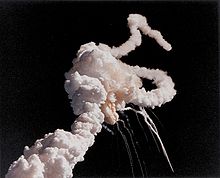 The space shuttle Challenger disintegrates on January 28, 1986.
The space shuttle Challenger disintegrates on January 28, 1986.
- In 1984, the Bhopal disaster resulted from a toxic MIC gas leak at the Union Carbide plant in Bhopal, India, killing 3,000 immediately and ultimately claiming 15,000–20,000 lives.
- On September 1, 1983, the Soviet Union shot down Korean Air Lines Flight 007, which was carrying 269 people.
- Japan Air Lines Flight 123, carrying 524 people, crashed on August 12, 1985 while on a flight from Tokyo to Osaka killing 520 of the people on board. This was the worst ever single-plane crash.
- In 1986, the NASA Space Shuttle Challenger disintegrated 73 seconds after launch, killing all of the crew onboard. This was the first disaster involving the destruction of a NASA space shuttle. A faulty O-ring was the cause of the accident.
- In 1986, the Chernobyl disaster, a large-scale nuclear meltdown in the Ukrainian SSR, Soviet Union, spread a large amount of radioactive material across Europe, killing 47 people, dooming countless others to future radiation-related cancer, and causing the displacement of 300,000 people.
- In 1989, the Exxon Valdez oil spill occurred in Alaska. Although not among the largest oil spills in history, its remote and sensitive location made it one of the most devastating ecological disasters ever.
Assaults
The 1980s were marked by several notable assassinations and assassination attempts:
- Musician and former Beatles member John Lennon was assassinated in New York City on December 8, 1980.
- Egyptian president Anwar Sadat was assassinated at a military parade in Cairo on October 6, 1981.
- Ronald Reagan was shot in Washington, D.C. on March 30, 1981 by John Hinckley, a mentally disturbed young man who also stalked Jodie Foster. Reagan's press secretary James Brady was also shot, along with a police officer and a Secret Service agent. The latter two recovered, along with Reagan himself, but Brady used a wheelchair thereafter and would become an advocate of gun control.
- Indian prime minister Indira Gandhi was assassinated on October 31, 1984 by her own bodyguards in response to the Indian Army's attack on Golden Temple to destroy Sikh Militant stronghold in Amritsar earlier in the decade.
- American singer-songwriter and musician Marvin Gaye was shot dead by his father at his home in Los Angeles on April 1, 1984.
- In 1984, there was an assassination attempt on the British Prime Minister, Margaret Thatcher and the Conservative Government by the IRA.
- Swedish Prime Minister Olof Palme was assassinated in February 1986. The assassin has never been identified.
- In May 1981, there was an assassination attempt on Pope John Paul II in Saint Peter's Square. The assassin was a Turkish man named Mehmet Ali Agca, who was subsequently sentenced to life in prison, but would be pardoned in 2000. At the time, it was widely believed that he was an agent of the Soviet Union or Bulgaria, due to the Pope's vocal anti-communist stance. Agca himself told dozens of conflicting stories over the years, and his motive remains unclear.
Technology
Electronics and computers
Arcade games and video games had been growing in popularity since the late 1970s, and by 1982 were a major industry. But a variety of factors, including a glut of low-quality games and the rise of home computers, caused a tremendous crash in late 1983. For the next three years, the video game market practically ceased to exist in the US. But in the second half of the decade, it would be revived by Nintendo, whose Famicom console had been enjoying considerable success in Japan since 1983. Renamed the Nintendo Entertainment System, it would claim 90% of the American video game market by 1989.
Computers experienced explosive growth in the '80s, going from being a toy for electronics hobbyists to a full-fledged industry. The IBM PC, launched in 1981, become the dominant computer for professional users. Commodore created the most popular home computers of both 8-bit and 16-bit generations. MSX standard was the dominant computer platform in Japan. Apple was committed to resisting the tide of IBM PC clones, while introducing the first Macintosh computer in 1984. It was the first commercially successful personal computer to use a graphical user interface and mouse,[1] which started to become general features in computers after the middle of the decade.
-
Commodore 64, with sales estimated at more than 17 million units in 1982–1994 became the best-selling computer model of all time.
-
The Macintosh 128K, the first commercially successful personal computer to use a graphical user interface, was introduced to the public in 1984.[2]
Walkman and Boomboxs, introduced during the late 1970s, became very popular and had a profound impact on the Music industry and youth culture. Consumer VCRs and video rental stores became commonplace as vhs won out over the competing betamax standard. In addition, in the early 1980s various companies began selling compact, modestly priced synthesizers to the public. This, along with the development of Musical Instrument Digital Interface (MIDI), made it easier to integrate and synchronize synthesizers and other electronic instruments for use in musical composition
-
Walkman WM-D6C Pro (1984)
-
1980s Boombox
-
1980s Synthesizer (Yamaha DX7)
Space exploration
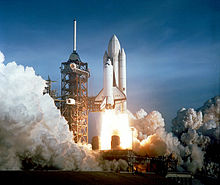 The Space Shuttle Columbia seconds after engine ignition, 1981
The Space Shuttle Columbia seconds after engine ignition, 1981
American interplanetary probes continued in the '80s, the Voyager duo being the most famous. After making a flyby of Jupiter in 1979, they visited Saturn in 1980–1981. Voyager 2 reached Uranus in 1986 (just a few days before the Challenger disaster), and Neptune in 1989 before the probes exited the solar system.
No American probes were launched to Mars in the 1980s, and the Viking probes, launched there in 1975, completed their operations by 1982. The Soviets launched two Mars probes in 1988, but they failed ignominiously.
The arrival of Halley's Comet in 1986 was met by a series of American, Soviet, Japanese, and ESA probes.
After a five-year hiatus, manned American space flights resumed with the launch of the space shuttle Columbia in April 1981. The shuttle program progressed smoothly from there, with three more orbiters entering service in 1983–1985. But that all came to an end with the tragic loss of the Challenger on January 28, 1986, taking with it seven astronauts, including Christia McAuliffe, who was to have been the first teacher in space. In full view of the world, a faulty O-ring on the right solid rocket booster burned through the external fuel tank and caused it to explode, destroying the shuttle in the process. Extensive efforts were made to improve NASA's increasingly careless management practices, and to make the shuttle safer. Flights resumed with the launch of Discovery in September 1988.
The Soviet manned program went well during the decade, experiencing only minor setbacks. The Salyut 6 space station, launched in 1977, was replaced by Salyut 7 in 1982. Then came Mir in 1986, which ended up operating for more than a decade, and was destined to be the last in the line of Soviet space stations that had begun in 1971. One of the Soviet Union's last "superprojects" was the Buran space shuttle; it was only used once, in 1988.
Automobiles
The American auto industry began the 1980s in a thoroughly grim situation, faced with poor quality control, rising import competition, and a severe economic downturn. Chrysler and American Motors (AMC) were near bankruptcy, and Ford was little better off. Only GM continued with business as usual. But the auto makers recovered with the economy by 1983, and in 1985 auto sales in the United States hit a new record. However, the Japanese were now a major presence, and would begin manufacturing cars in the US to get around tariffs. In 1986, Hyundai became the first Korean auto maker to enter the American market. In the same year, the Yugoslavian-built Yugo was brought to the US, but the car was so small and cheap, that it became the subject of countless jokes. It was sold up to 1991, when economic sanctions against Yugoslavia forced its withdrawal from the American market.
As the decade progressed, cars became smaller and more efficient in design. In 1983, Ford design teams began revolutionizing existing automobiles with a new philosophy which was called "Aero". The idea was to design cars to incorporate pro-aerodynamic round styling to increase airflow and decrease drag while in motion. The Thunderbird was one of the first cars to receive these design changes and it was an instant hit. Later, in 1985, Ford released the Taurus which was considered a dramatic step in automobile design and its aerodynamic style was so popular and revolutionary at the time that other manufacturers scrambled to emulate it which eventually caused a design revolution which is still evident to the present day which increasingly round and aerodynamic designed being implemented by many companies worldwide.
GM began suffering significant losses in the late-1980s, partially the result of chairman Roger Smith's restructuring attempts, and partially because of increasingly stale and unappealing cars. For example, "yuppies" increasingly favored European luxury cars to Cadillac. In 1985, GM started Saturn (the first new American make since the Edsel), with the goal of producing high-quality import fighters. Production would not begin until 1990, however.
Chrysler introduced its new compact, front-wheel drive K-cars in 1981. Under the leadership of Lee Iacocca, the company turned a profit again the following year, and by 1983 paid off its government loans. A seemingly endless succession of K-cars followed. But the biggest success was the arrival of the minivans in 1984. These proved a huge hit, and despite competition, they would dominate the van market for more than a decade. And in 1987, Chrysler purchased the Italian makes of Lamborghini and Maserati. In the same year, Chrysler bought AMC from Renault laying to rest the last significant independent U.S. automaker, but acquiring the hugely profitable Jeep line and continuing the Eagle brand until the late 1990s.
The DeLorean DMC-12 was the brainchild of John DeLorean, a flamboyant former GM executive. Production of the gull-winged sports car began in Northern Ireland in 1981. John DeLorean was arrested in October 1982 in a sting operation where he was attempting to sell cocaine to save his struggling company. He was acquitted of all charges in 1984, but too late for the DeLorean Motor Company, which closed down in 1983. The DMC-12 gained renewed fame afterward as the time machine in the Back to the Future motion picture trilogy.
Porsche introduced the 959 sports car in 1986, the fastest car in the world back then, which had the ability to reach a top speed of more than 200 mph (320 km/h). Never before car manufacturers managed to exceed the 200 mph barrier. Just one year later, Porsche's rival Ferrari startled the world introducing the F40, at that point the fastest car in the world, even faster than the 959 from Porsche.
The imposition of CAFE fuel-mileage standards in 1979 spelled the end of big-block engines, but performance cars and convertibles reemerged in the 1980s. Turbochargers were widely used to boost the performance of small cars, and technology from fuel injection began to take over from the widely used application of carburetors by the late 1980s. Front-wheel drive also became dominant.
The eighties marked the decline of European brands in North America by the end of the decade. Renault, Citroen, and Peugeot ceased importation by the end of the decade. Alfa Romeo would continue until 1993. Fiat also ceased imports to North America in the eighties.
Economics
- International debt crisis in developing countries, reliance of these countries on aid from the International Monetary Fund.
- Spread of neoliberal economics in developed world.
- Mexico suffers from a debt crisis starting in 1982. Economic problems worsened in 1985 by resignation of most officials of the Mexican government after a failed response of emergency aid in the Mexico City earthquake (September 19) just after the 175th anniversary of Independence holiday (September 16). In 1988, Carlos Salinas de Gortari won a controversial presidential election amid charges of voter fraud, bribery, corruption and other abuses of power.
- Enactment of the Canada-United States Free Trade Agreement in 1989 to further establish a strong economic bond between the two prosperous neighbor countries of North America.
- Under the leadership of Deng Xiaoping, China embarked on extensive reforms in the 1980s, introducing market economics and downgrading ideology. Increasing demands for political freedom culminated in the Tiananmen Square Massacre in June 1989, when tanks and troops of the People's Liberation Army crushed student protesters who were camped in the square, killing or injuring 3000 or more people. Hardliners took over the government afterwards, and China ended the '80s as an international pariah.
- The Solidarity movement began in Poland in 1980, involving workers demanding political liberalization and democracy in Poland. Attempts by the communist government to crush the Solidarity movement failed and negotiations between the movement and the government took place. Solidarity would be instrumental in encouraging people in other communist states to demand political reform.
- The 1980s saw a revival of capitalism and laissez-faire economics. Consumers became more sophisticated in their tastes (a trend begun in the 1960s), and things such as European cars and designer clothing became fashionable in the US.
- The financial world and the stock market were glamorized in a way they had not been since the 1920s, and figures like Donald Trump and Michael Milken were widely seen as symbols of the decade. Widespread fear of Japanese economic strength would grip the United States in the '80s.
- During the 1980s, for the first time in world history, transpacific trade (with East Asia, such as China, and Latin America, primarily with Mexico) equaled that of transatlantic trade (with Western Europe or with neighboring Canada).,[3] solidifying American economic power.[4]
Society
The 1980s was also an era of tremendous population growth around the world, surpassing even the 1970s and 1990s, thus arguably being the largest in human history. Population growth was particularly rapid in a number of African, Middle Eastern, and South Asian countries during this decade, with rates of natural increase close to or exceeding 4% annually.
Additional significant world-wide events
 September 1, 1985: A joint American-French expedition located the wreck of the RMS Titanic.
September 1, 1985: A joint American-French expedition located the wreck of the RMS Titanic.
Worldwide
- Beginning of the AIDS pandemic.
- There were numerous protests demanding that the US government[clarification needed] take action against AIDS, which were fuelled by the AIDS-related deaths of celebrities such as Rock Hudson and Liberace, and by the case of Ryan White, a child who became infected by the HIV virus through contaminated blood supplies.
- National safety campaigns raised awareness of seat belt usage to save lives in car accidents, helping to make the measure mandatory in most parts of the world by 1990. Similar efforts arose to push child safety seats and bike helmet use, already mandatory in a number of regions.
- Rejection of smoking based on health concerns increased throughout the western world.
- Political correctness in the 1980s and increasingly in the following 1990s, was a trend of behaviour, in western societies, designed to fit the mores of those opposed to forms of prejudice against certain minority groups .
- The role of women in the workplace increased greatly. Continuing the 1970s' trend, more women[quantify] in the English-speaking world took to calling themselves "Ms.", rather than "Mrs." or "Miss." A similar change occurred in Germany, with women choosing "Frau" instead of "Fräulein" in an effort to disassociate marital status from title. In most western countries, women began[citation needed] to exercise the option of keeping their maiden names after marriage; in Canada, legislation was enacted to end the practice of automatically changing a woman's last name upon marriage.
- Opposition to nuclear power plants grew, especially after the catastrophic 1986 Chernobyl accident.
- Environmental concerns intensified. In the United Kingdom, environmentally friendly domestic products surged in popularity. Western European countries adopted "greener" policies to cut back on oil use, recycle most of their nations' waste, and increase focus on water and energy conservation efforts. Similar "eco-activist" trends appeared in the US in the late 1980s.
- Increased awareness and opposition to white-minority apartheid rule in South Africa occurred in the western world.[dubious ]
- Counterculture in the eastern world revolved around "pro-democracy" stances in opposition to multiple communist states perceived as authoritarian.
- Gay rights became more widely accepted in the Western world.[citation needed]
- Militancy against communist governments in Europe and Asia, collapse of the Warsaw Pact precipitated the end of the Cold War.
- A joint American-French expedition discovers the wreck of the RMS Titanic on 1 September 1985 at a depth of 2.5 miles (4 km) at 41°43′55″N 49°56′45″W / 41.73194°N 49.94583°W.
Africa
- Opposition against Apartheid in South Africa and worldwide grows to a mass international condemnation of racial segregation policies comes to a peak by December 1989 in the Springbok summit when SA President de Klerk grants clemency to imprisoned ANC activist Nelson Mandela who was released in February 1990.
- The 1984–1985 famine in Ethiopia occurred, resulting in international efforts to help the Ethiopian people, including the famous Live Aid concert in July 1985.
Americas
- Ten thousand Cubans stormed the Peruvian embassy in Havana seeking political asylum on 6 April 1980. On 7 April the Cuban government granted permission for the emigration of Cubans seeking refuge in the Peruvian embassy.
- The 1986 World's Fair, Expo 86, was held in Vancouver, Canada. It was the last fair held in North America and was considered a great success in comparison to the then-recent American Expositions.[citation needed]
- In 1984 crack cocaine reached American cities and the marked the start of the crack epidemic.
Asia
- Vietnam continued to occupy Cambodia and battle the Khmer Rouge throughout the entire decade. Relations with China remained hostile, and there were frequent border skirmishes, although none were comparable to the 1979 conflict. The country remained one of Asia's poorest and was totally dependent on Soviet economic assistance. Mikhail Gorbachev began reducing foreign aid to the communist bloc in the late 1980s, and this combined with the deaths of elderly Vietnamese leaders such as Le Duan brought about the gradual adoption of a relatively free market system similar to that of China.
- Benigno "Ninoy" Aquino, husband of the first female president of the Philippines was shot dead at the Manila International Airport on 21 August 1983. The killers were never identified.
Popular culture
The most prominent events and trends in popular culture of the decade include:
Music
- See also 1980s in music, Timeline of musical events#1980s
 Stage view of Live Aid concert at Philadelphia's JFK Stadium in the United States in 1985. The concert was a major global international effort by musicians and activists to sponsor action to send aid to the people of Ethiopia who were suffering from a major famine.
Stage view of Live Aid concert at Philadelphia's JFK Stadium in the United States in 1985. The concert was a major global international effort by musicians and activists to sponsor action to send aid to the people of Ethiopia who were suffering from a major famine.
In the United States, MTV was launched and music videos began to have a larger effect on the record industry. Pop artists such as Michael Jackson, Duran Duran, Prince, Madonna, and Queen mastered the format and helped turn this new product into a profitable business. New Wave and Synthpop were developed by many British and American artists, and became popular phenomena throughout the decade, especially in the early and mid eighties.
Michael Jackson was a popular entertainer of the 1980s and his leather jacket, glove and Moonwalk dance were often imitated. Jackson's 1982 album Thriller became—and currently remains—the best-selling album of all time, with sales estimated by various sources as somewhere between 65 and 110 million copies worldwide.
Madonna was regarded as the most ground breaking female artist of the decade; she was also noted for her many fashion incarnations. The keyboard synthesizer and drum machine were among the most popular in music in the 1980s, especially in New Wave music. After the 1980s electronic instruments were no longer popular in rock but continued to be the main component of mainstream pop.
By 1989, the hip hop scene had evolved, gaining recognition and exhibiting a stronger influence on the music industry. This time period is also considered part of the golden age of hip hop. The Beastie Boys, Public Enemy, Run-D.M.C., Grandmaster Flash and the Furious Five, Boogie Down Productions, N.W.A, LL Cool J, De La Soul, A Tribe Called Quest, EPMD, Eric B. & Rakim, Ice-T, DJ Jazzy Jeff & The Fresh Prince, 2 Live Crew, Tone Lōc, Biz Markie, the Jungle Brothers and others experienced success in this genre.
The Techno style of electronic dance music emerged in Detroit, Michigan during the mid to late 1980s. The House music style, another form of electronic dance music, emerged in Chicago, Illinois in the early 1980s. It was initially popularized in mid-1980s discothèques catering to the African-American, Latino and gay communities, first in Chicago, then in New York City and Detroit. It eventually reached Europe before becoming infused in mainstream pop and dance music worldwide.
Hard rock, heavy metal, and glam metal became some of the most dominant music genres of the decade, peaking with the arrival of such bands as Guns N' Roses, Metallica, Iron Maiden, Bon Jovi, Def Leppard, Poison, Europe, Megadeth, Slayer, Anthrax, Mötley Crüe, and virtuoso guitarists such as Joe Satriani and Yngwie Malmsteen. The scene also helped 1970s hard rock artists such as AC/DC, Ozzy Osbourne, KISS, Ronnie James Dio, and Judas Priest reach a new generation of fans.
Punk rock continued to make strides in the musical community; it gave birth to many sub-genres like hardcore, which has continued to be moderately successful, giving birth in turn to a few counterculture movements, most notably the Straight Edge movement which began in the early era of this decade. College rock caught on in the underground scene of the 1980s in a nationwide movement with a distinct D.I.Y approach. Bands like the Pixies, R.E.M., The Replacements, Sonic Youth, XTC, The Smiths, etc. experienced success in this genre.
Several notable music artists died of unnatural causes in the 1980s. John Lennon was shot outside of his home in New York City on the night of December 8, 1980. Tim Hardin died of a heroin overdose on December 29, 1980. Bob Marley died from a lentiginous skin melanoma on May 11, 1981. Marvin Gaye was shot dead by his father at his home in Los Angeles on April 1, 1984, one day before what would have been his 45th birthday. Ozzy Osbourne's guitarist Randy Rhoads died in an airplane crash on March 18, 1982. Metallica bassist Cliff Burton was killed in a bus accident in Sweden on September 27, 1986. Andy Gibb died in 1988 as a result of myocarditis.
1985's Live Aid concert, featuring many artists, promoted attention and action to send food aid to Ethiopia whose people were suffering from a major famine.
Film
Main article: 1980s in film- Oscar winners: Ordinary People (1980), Chariots of Fire (1981), Gandhi (1982), Terms of Endearment (1983), Amadeus (1984), Out of Africa (1985), Platoon (1986), The Last Emperor (1987), Rain Man (1988), Driving Miss Daisy (1989)
- The 15 highest-grossing films of the decade are (in order from highest to lowest domestic grossing): E.T. the Extra-Terrestrial, Star Wars Episode VI: Return of the Jedi, Star Wars Episode V: The Empire Strikes Back, Indiana Jones and the Last Crusade, Batman, Rain Man, Raiders of the Lost Ark, Back to the Future, Who Framed Roger Rabbit, Top Gun, Indiana Jones and the Temple of Doom, Back to the Future Part II, Crocodile Dundee, Fatal Attraction and Beverly Hills Cop.[5]
 The highest-grossing film of the decade was "E.T. the Extra-Terrestrial" (1982)
The highest-grossing film of the decade was "E.T. the Extra-Terrestrial" (1982)
This was the period when the 'high concept' films were introduced. The movies were supposed to be easily marketable and understandable, and, therefore, they had short cinematic plots that could be summarized in one or two sentences. The modern Hollywood blockbuster is the most popular film format from the 1980s. Producer Don Simpson[6] is usually credited with the creation of the high-concept picture of the modern Hollywood blockbuster.
The 80s also spawned the Brat Pack films, many of which were directed by John Hughes. Films such as The Breakfast Club, Fast Times at Ridgemont High, Porky's, Pretty In Pink, Sixteen Candles, Weird Science and Valley Girl were popular teen comedies of the era and launched the careers of several major celebrities such as: Emilio Estevez, Anthony Michael Hall, Forest Whitaker, Jennifer Jason Leigh, Judd Nelson, Molly Ringwald, Sean Penn and Nicolas Cage. Other popular films included About Last Night..., Bill & Ted's Excellent Adventure, Dirty Dancing, Flashdance, Footloose, Raging Bull and St. Elmo's Fire which also launched the careers of high profile celebrities like Demi Moore, Joe Pesci, Keanu Reeves, Kevin Bacon, Rob Lowe and Patrick Swayze.
Horror films were a popular genre during the decade, with several notable horror franchises being born during the 1980s. Among the most popular were the A Nightmare on Elm Street, Friday the 13th and Hellraiser franchises. Aside from these films, the concept of the B horror film gave rise to a plethora of horror films that went on to earn a cult status. An example of such is the 1981 film The Evil Dead, which marked the directorial debut of Sam Raimi.
Several action film franchises were also launched during the 1980s. The most popular of these were the Beverly Hills Cop, Die Hard, Lethal Weapon and Rambo franchises. Other action films from the decade which are of notable status include The Terminator and Predator. These films propelled the careers of modern celebrities such as Arnold Schwarzenegger, Bruce Willis, Eddie Murphy, Mel Gibson and Sylvester Stallone to international recognition.
Television
Main article: 1980s in televisionMTV was launched in the United States in 1981 and had a profound impact on the music industry and popular culture further ahead, especially during its early run in the 1980s and early 1990s.
Some of the most popular TV series which premiered during the 1980s include: "Alf", "Airwolf", "The A-Team", "Dynasty", "Dallas", "Knight Rider", "MacGyver", "Magnum, P.I.", "Miami Vice", "Diff'rent Strokes", "The Jeffersons", "The Facts of Life", "The Cosby Show", "Murder, She Wrote","21 Jump Street", "Star Trek: The Next Generation", "Night Court", "Who's the Boss?", "Family Matters", "Quantum Leap", "Saved by the Bell", "Roseanne", "Full House", "The Golden Girls", "Cheers", "Growing Pains", "Family Ties", "Seinfeld", "The Simpsons" and "Married... with Children".
The 1980s was the decade of transformation in television. Cable television became more accessible and therefore, more popular. By the middle of the decade, almost 70% of the American population had cable television and over 85% were paying for cable services such as HBO or Showtime.[7]
The 1980s was also the heyday of nighttime soap operas such as Dallas and Dynasty.
TV talk shows expanded in popularity; The Tonight Show with Johnny Carson remained popular into its third decade, and some of the most viewed newer shows were hosted by Geraldo Rivera, Arsenio Hall and David Letterman.[8]
The 1980s also was prominent for spawning several popular children's cartoons such as "ThunderCats", "Voltron", "Transformers", "Masters of the Universe", "G.I. Joe: A Real American Hero", "Inspector Gadget", "Teenage Mutant Ninja Turtles" and "Garfield and Friends".
Sports
- The 1980 Summer Olympics in Moscow were disrupted by a boycott led by the United States and 64 other countries in protest of the 1979 Soviet invasion of Afghanistan.
- The 1980 Winter Olympics are remembered for the Miracle on Ice, where a young United States hockey team defeated the heavily favored Soviet Red Army team and went on to win the gold medal.
- The New York Islanders won the Stanley Cup for 4 straight years in 1980, 1981, 1982, and 1983. The Islanders also became the second NHL expansion team after the Philadelphia Flyers to win the Cup. Since their last Cup win in 1983, they are currently the only team of the four major North American sports leagues (NHL, NFL, NBA, & MLB) to win 4 consecutive championships, and hold the NHL record for most consecutive playoff series' wins at 19(1980 Playoffs - 1984 Playoffs).
- The 1984 Summer Olympics in Los Angeles were boycotted by the Soviet Union and most of the communist world (China, Romania, and Yugoslavia participated in the games) in retaliation for the 1980 boycott.
- The 1984 Winter Olympics are held in Sarajevo, Yugoslavia (now Sarajevo, Bosnia and Herzegovina). Yugoslavia becomes the second communist country to host the Olympic Games, but unlike the Soviet Union in 1980, there were no boycotts of the Games by western countries.
- The Jamaica national bobsled team received major media attention and stunned the world at the 1988 Winter Olympics in Calgary, Canada for its unexpected good performance. It overcame the stereotype that northern countries were the only efficient competitors in winter Olympic Games due to their experiencing an actual winter. The events surrounding the Jamaica bobsled team in 1988 would lead to the creation of the Disney movie Cool Runnings five years later which was based on Jamaica's 1988 bobsled team.
- The 1988 Summer Olympics are held in Seoul, South Korea. Attempts to include North Korea in the games were unsuccessful, and it boycotted along with six other countries, but with 160 nations participating, it had the highest attendance of any Olympics to date.
- FIA bans Group B rallying after a series of deaths and injuries take place in the 1986 season.
- Canadian hockey player Wayne Gretzky's rise to fame in the NHL would coincide with the Edmonton Oilers' first 4 Stanley Cup championships (1984, 1985, 1987, & 1988) and becoming the second NHL dynasty team of the 1980s.
- On August 9, 1988, in what became the biggest trade in NHL history (also known as "The Trade"), Wayne Gretzky was traded along with teammates Marty McSorley and Mike Krushelnyski from Edmonton to the Los Angeles Kings in exchange for Martin Gelinas, Jimmy Carson, three first round draft picks, and $15 million cash.
- American basketball player Michael Jordan bursts onto the scene in the NBA during the 1980s, bringing a surge in popularity for the sport and becoming one of the most beloved sports icons in the United States.
- On November 26, 1986 Mike Tyson became the youngest boxing Heavyweight Champion of the World at age 20.
- West Germany won UEFA championship 1980 in Italy.
- Italy won FIFA world cup 1982 in Spain.
- France hosted and won the UEFA football championship in 1984.
- Argentina won FIFA world cup 1986 in Mexico.
- Netherlands won UEFA football championship in 1988.
- Liverpool FC were the most successful club side of the era, becoming English champions on six occasions (1980, 1982, 1983, 1984, 1986, and 1988) and winning two European Cups (1981, 1984). They also won the FA Cup in 1986, completing the first double in their history, and four consecutive League Cup titles from 1981 to 1984.
- Other highly successful club sides of the 1980s include Juventus (7 major honours won), Real Madrid (10 major honors won), Bayern Munich (9 titles won) and PSV Eindhoven (4 times Dutch champions and European Cup winners in 1988).
Video gaming
See also: 1980s in video gaming Pac-Man (1980) became Immensely popular and an icon of 1980s popular culture.
Pac-Man (1980) became Immensely popular and an icon of 1980s popular culture.
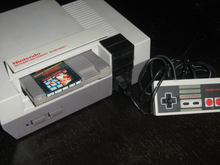 The Nintendo Entertainment System was released in the mid 1980s and became the best-selling gaming console of its time
The Nintendo Entertainment System was released in the mid 1980s and became the best-selling gaming console of its time
- Popular video games include: Turrican, Pac-Man, Super Mario Bros., The Legend of Zelda, Donkey Kong, Frogger, Digger, Tetris and Golden Axe.
- Pac-Man (1980) was the first game to achieve widespread popularity in mainstream culture and the first game character to be popular in his own right.
- Handheld electronic LCD games introduced into the youth market segment.
- North American video game crash of 1983
- The primary gaming computers of the 1980s emerged in 1982: the Commodore 64 and ZX Spectrum.
- Nintendo finally decided in 1985 to release its Famicom in the United States under the name Nintendo Entertainment System (NES). It was bundled with Super Mario Bros. and it suddenly became a success. The NES dominated the American and Japanese market until the rise of the next generation of consoles in the early 1990s, causing some to call this time the Nintendo era.
- In 1989 Nintendo released the Game Boy, a monochrome handheld console. Sega released its 16-bit console, Mega Drive/Genesis.
Fashion
Main article: 1980s in fashion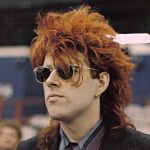 Tom Bailey of the Thompson Twins in 1986 with the trendy Big hair style achieved with liberal applications of mousse and hairspray.
Tom Bailey of the Thompson Twins in 1986 with the trendy Big hair style achieved with liberal applications of mousse and hairspray.
 Ray-Ban sunglasses
Ray-Ban sunglasses
The beginning of the decade was marked by the New Romantic movement and later by fashion inspired by heavy metal bands, including teased hair, ripped jeans and neon clothing. Some clothing and mens hairstyles had influences from the 1950s, especially in the first part of the decade.
Significant hairstyle trends of the 1980s include the Perm (started popularity in the late 1970s), the Mullet (evolved from the 1970s to a cleaner look using hair gel), the Jheri curl, the Flattop, the Hi-top fade and Big hair.
Significant clothing trends of the 1980s include Shoulder pads, Jean jackets, Leather pants, Aviator jackets, Jumpsuits, Diane von Fürstenberg Wrap Dress, Members Only Jackets, Skin-tight acid-washed jeans, Miniskirts, Leggings and Leg warmers (popularized in the film "Flashdance"), Off-the-Shoulder Shirts and Cut Sweatshirts (popularized in the film "Flashdance").
Additional significant trends of the 1980s include Headbands, Ray-Ban Aviator sunglasses (popularized in the film "Top Gun"), Ray-Ban Wayfarer sunglasses (popularized in the films "Risky Business" and "The Blues Brothers"), Swatch watches, Slap bracelets (popular fad among children, pre-teens and teenagers in the late 1980s and early 1990s and was available in a wide variety of patterns and colors), and the Rubik's cube (became a popular fad throughout the decade).
People
World leaders
- General Leopoldo Galtieri (Argentina)
- President Raúl Alfonsín (Argentina)
- Chancellor Bruno Kreisky (Austria)
- Chancellor Fred Sinowatz (Austria)
- Chancellor Franz Vranitzky (Austria)
- Prime Minister Bob Hawke (Australia)
- Prime Minister Malcolm Fraser (Australia)
- President João Figueiredo (Brazil)
- President José Sarney (Brazil)
- Prime Minister Pierre Trudeau (Canada)
- Prime Minister Brian Mulroney (Canada)
- General Augusto Pinochet (Chile)
- Deng Xiaoping (People's Republic of China)
- President Chiang Ching-kuo (Republic of China on Taiwan)
- President Julio César Turbay Ayala (Colombia)
- President Belisario Betancur Cuartas(Colombia)
- President Virgilio Barco Vargas (Colombia)
- Prime Minister Poul Schlüter (Denmark)
- Erich Honecker (East Germany)
- President Anwar Sadat (Egypt) - until 1981
- President Hosni Mubarak (Egypt)
- President Daniel Ortega (Nicaragua)
- President Mengistu Haile Mariam (Ethiopia)
- President Urho Kekkonen (Finland)
- President Mauno Koivisto (Finland)
- President François Mitterrand (France)
- Prime Minister Andreas Papandreou (Greece)
- Prime Minister Indira Gandhi (India)
- Prime Minister Rajiv Gandhi (India)
- President Suharto (Indonesia)
- Supreme Leader Ruhollah Khomeini (Iran)
- President Abulhassan Banisadr (Iran)
- President Mohammad-Ali Rajai (Iran)
- President Ali Khamenei (Iran)
- Supreme Leader Ali Khamenei (Iran) - from 1989
- President Akbar Hashemi Rafsanjani (Iran) - from 1989
- President Saddam Hussein (Iraq)
- President Patrick Hillery (Ireland)
- Taoiseach Charles Haughey (Ireland)
- Taoiseach Garret FitzGerald (Ireland)
- Prime Minister Menachem Begin (Israel)
- Prime Minister Shimon Peres (Israel)
- Emperor Hirohito (Japan)
- Prime Minister Yasuhiro Nakasone (Japan)
- Emir Jabir al-Ahmad al-Jabir al-Sabah (Kuwait)
- President Muammar Gaddafi (Libya)
- Pope John Paul II
- President Hastings Kamuzu Banda (Malawi)
- Prime Minister Mahathir Mohamad (Malaysia)
- Prime Minister Dom Mintoff (Malta)
- Prime Minister Karmenu Mifsud Bonnici (Malta)
- Prime Minister Eddie Fenech Adami (Malta)
- President Miguel de la Madrid Hurtado (Mexico)
- President Samora Machel (Mozambique)
- Prime Minister Robert Muldoon (New Zealand)
- Prime Minister David Lange (New Zealand)
- Prime Minister Geoffrey Palmer (New Zealand)
- Queen Beatrix (Netherlands)
- Prime Minister Ruud Lubbers (Netherlands)
- General Muhammad Zia-ul-Haq (Pakistan)
- General Manuel Noriega (Panama)
- President Ferdinand Marcos (Philippines)
- President Corazon Aquino (Philippines)
- President Wojciech Jaruzelski (Poland)
- President Nicolae Ceauşescu (Romania)
- Head of State Malietoa Tanumafili II (Samoa)
- King Khaled (Saudi Arabia)
- King Fahd (Saudi Arabia)
- Prime Minister Lee Kuan Yew (Singapore)
- President and Prime Minister P.W. Botha (South Africa)
- President Chun Doo-hwan (South Korea)
- General Secretary Leonid Brezhnev (Soviet Union)
- General Secretary Mikhail Gorbachev (Soviet Union)
- King Juan Carlos (Spain)
- President Felipe González (Spain)
- Prime Minister Ranasinghe Premadasa of Sri Lanka
- Prime Minister Olof Palme (Sweden)
- President Hafiz Al-Asad (Syria)
- Prime Minister Prem Tinsulanonda (Thailand)
- Prime Minister Turgut Ozal (Turkey)
- Elizabeth II (United Kingdom and the Commonwealth Realms)
- Prime Minister Margaret Thatcher (United Kingdom)
- President Jimmy Carter (United States) - until 1981
- President Ronald Reagan (United States)
- President George H.W. Bush (United States) - from 1989
- Chancellor Helmut Schmidt (West Germany)
- Chancellor Helmut Kohl (West Germany)
- President Josip Broz Tito (Yugoslavia)
- President Mobutu Sese Seko (Zaire)
- President Robert Mugabe (Zimbabwe)
- Prime Minister Robert Muldoon, David Lange, (New Zealand)
Entertainers
 Michael J. Fox, 1988
Michael J. Fox, 1988
Musicians
Sports figures
Film makers
- Steven Spielberg
- George Lucas
- Tim Burton
- James Cameron
- Stanley Kubrick
- Brian De Palma
- Ridley Scott
- John Hughes
- David Cronenberg
- Wes Craven
- Oliver Stone
- John Carpenter
See also
- 1980s in music
- 1980s in fashion
- 1980s in television
- 1980s in video gaming
- 1980s in literature
- Andy McSmith. No Such Thing as Society: A History of Britain in the 1980s. Constable, 2010. ISBN 978-1-84901-009-2
Timeline
The following articles contain brief timelines which list the most prominent events of the decade:
1980 • 1981 • 1982 • 1983 • 1984 • 1985 • 1986 • 1987 • 1988 • 1989
References
- ^ Polsson, Ken (2009-07-29). "Chronology of Apple Computer Personal Computers". http://www.islandnet.com/~kpolsson/applehis/appl1984.htm. Retrieved 2009-08-27. See May 3, 1984.
- ^ Linzmayer, Owen W. (2004). Apple Confidential 2.0. No Starch Press. p. 113. ISBN 1-59327-010-0. http://www.owenink.com.
- ^ "The Next Hundred Years", George Friedman, 2009, pg 4
- ^ "The Next Hundred Years", George Friedman, 2009, pg 45
- ^ All-Time Worldwide Box Office
- ^ Fleming, Charles (1998). High concept: Don Simpson and the Hollywood culture of excess. Doubleday. ISBN 978-0-385-48694-1.
- ^ The Politics and Pop Culture of the 1980s The Eighties Club. Retrieved on 2010-03-08
- ^ An overview on 80s Television Retrieved on 2010-03-08
External links
- Memories of the toys, games, TV, movies and music of the 1980s
- The UK in the 1980s
- Australia in the 1980s
- 80s Culture, Fashion, Movies, TV, and Music
- 80s Nostalgia - a nostalgic look back at our favourite decade.
- '80s Actual - 1980s pop culture and news - the decade as it was lived in the UK.
- KajaFax - The No.1 Fan community for 80s pop band KajaGooGoo, Limahl and all band member projects
Categories:
Wikimedia Foundation. 2010.

